Chapter 3. JBoss EAP installer
You can use the JBoss EAP installer to install, configure, and uninstall a JBoss EAP instance. You can use the JBoss EAP installer on all platforms supported by JBoss EAP.
3.1. Downloading and installing the JBoss EAP installer
You can use the JBoss EAP installer that is available from the Red Hat Customer Portal. The .jar archive can be used to run either the graphical or text-based installers. The installer is the preferred way to install JBoss EAP on all supported platforms.
Prerequisites
- Set up an account on the Red Hat Customer Portal.
- Review the JBoss EAP 7 supported configurations and ensure that your system is supported.
- Install a supported Java Development Kit (JDK).
Procedure
- Log in to the Red Hat Customer Portal.
- From the Product Downloads list, select Red Hat JBoss Enterprise Application Platform.
- Click Downloads.
- From the Version drop-down list, select 7.4.
- Find Red Hat JBoss Enterprise Application Platform 7.4.0 Installer file in the list and click the Download link.
3.2. Running the JBoss EAP graphical installer
The graphical installer offers a convenient way for you to install, configure, and uninstall a JBoss EAP instance. Additionally, you can use the graphical installer to access many optional configuration options.
Prerequisites
- Set up an account on the Red Hat Customer Portal.
- Review the JBoss EAP 7 supported configurations and ensure that your system is supportable.
- Download the JBoss EAP installation package.
- Install a supported Java Development Kit (JDK).
Procedure
- Open a terminal and navigate to the directory containing the downloaded JBoss EAP installer file.
Run the graphical installer using the following command:
$ java -jar jboss-eap-7.4.0-installer.jar
- Choose the desired language for the installer and click OK.
- Agree with the prompt for The EULA for RED HAT JBOSS MIDDLEWARE by selecting "I accept the terms of this license agreement", and then click Next.
- Select the installation path for JBoss EAP, and click Next.
Select the components to install. Required components are disabled for deselection.
Figure 3.1. JBoss EAP installer - Component selection screen

- Create an administrative user and assign a password. Then click Next.
- Review your installation options, and then click Yes.
- When the installation progress completes, click Next.
Choose a default configuration for your JBoss EAP installation, or choose to perform an advanced configuration with the installer.
NoteEven if you choose a default configuration, you can still alter your configuration using the JBoss EAP management interfaces at a later time.
Select Perform default configuration, or select Perform advanced configuration and select the items to configure, and then click Next.
Figure 3.2. JBoss EAP installer - Configure runtime environment screen
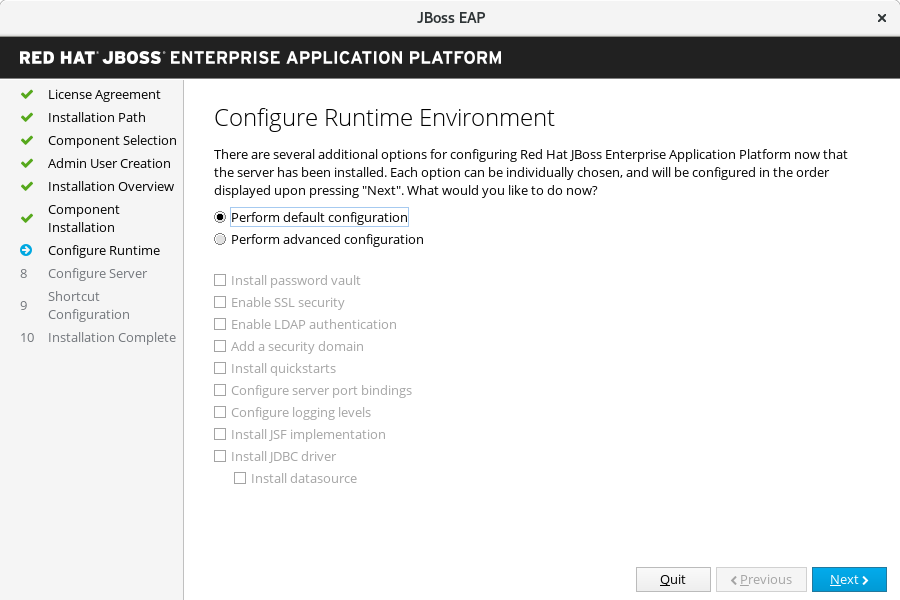
The following configuration steps are optional:
Configure password vault
You can use the Configure Password Vault option to install a password vault in the advanced configuration of the runtime environment.
- Configure a password vault to store your sensitive passwords in an encrypted keystore, and then click Next.
For more information, see the password vault documentation in the How To Configure Server Security guide.
Figure 3.3. JBoss EAP installer - Configure password vault screen
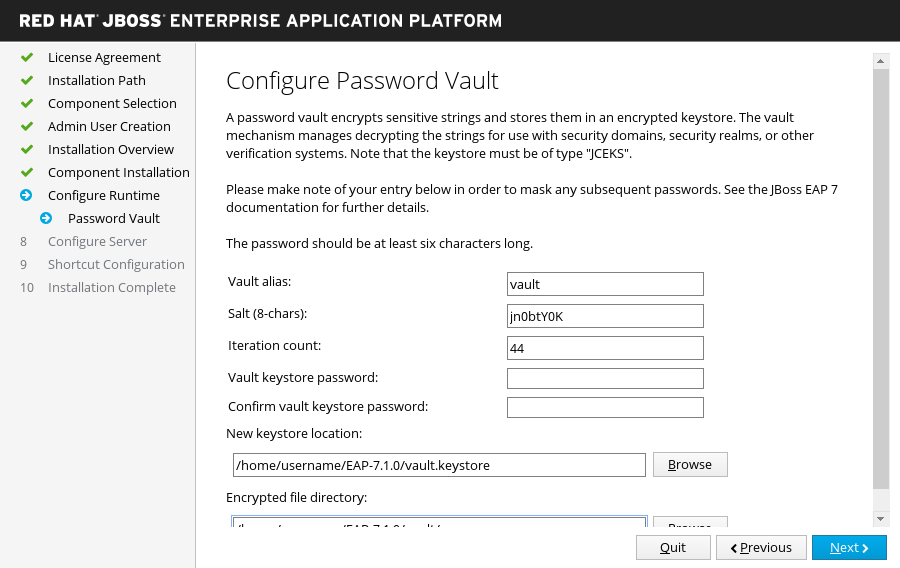
SSL Security
You can enable SSL Security in the advanced configuration of the runtime environment by specifying the location of the keystore and the password for securing the JBoss EAP management interfaces.
a. Specify the location of the keystore and the password for securing the JBoss EAP management interfaces.
b. When you have specified these values, click Next.
For more information, see the documentation on securing the management interfaces in the How To Configure Server Security guide.
WarningRed Hat recommends that SSLv2, SSLv3, and TLSv1.0 be explicitly disabled in favor of TLSv1.1 or TLSv1.2 in all affected packages.
LDAP configuration
You can enable the LDAP server to be the authentication and authorization authority as follows:
a. Select Configure Runtime.
b. Select Enable LDAP authentication.
c. On the LDAP Configuration screen, complete the required configurations and click Next.
For more information, see the LDAP documentation in How to Configure Identity Management.
Figure 3.4. JBoss EAP installer - LDAP configuration screen
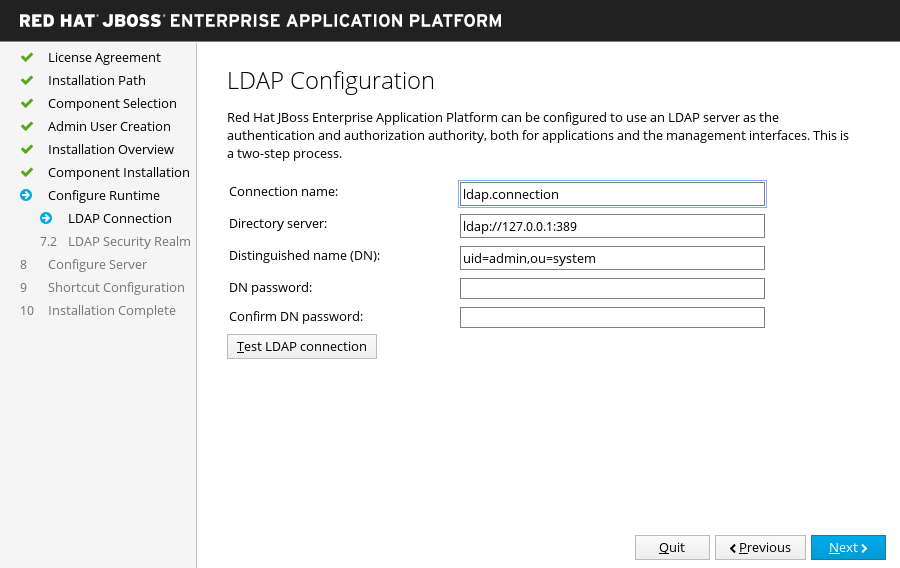
LDAP security realm configuration
You can enable LDAP authentication in the advanced configuration of the runtime environment by using the LDAP connection, which is defined in the previous step. Enabling LDAP authentication creates a new security realm and this realm becomes associated with the management interfaces.
- Specify the values for your LDAP Security Realm, and then click Next.
For more information, see the LDAP documentation in How to Configure Identity Management.
Figure 3.5. JBoss EAP installer - LDAP security realm configuration screen
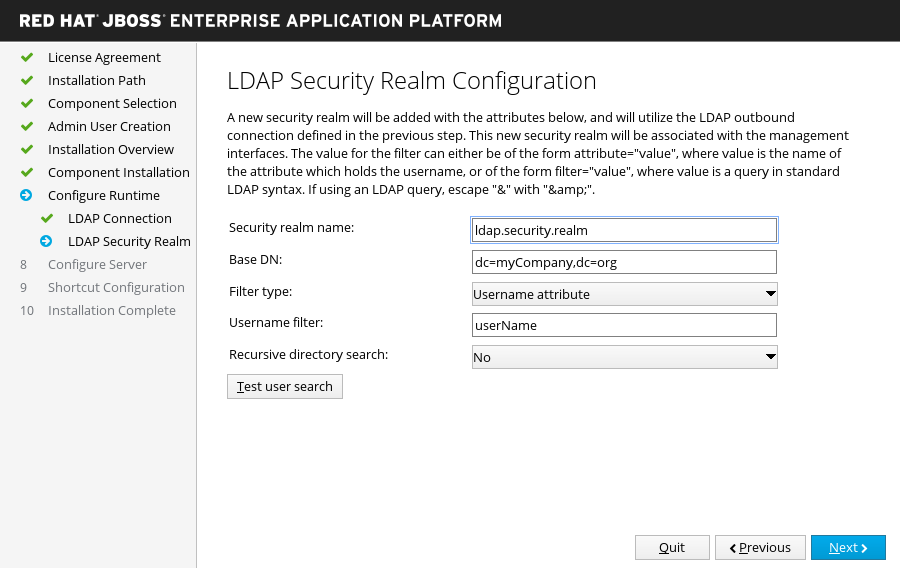
Security Domain Configuration
You can add a security domain in the advanced configuration of the runtime environment by configuring a security domain for the JBoss EAP server instance. Most of the fields are already populated with default values and do not need modification.
a. Configure the security domain for your JBoss EAP server instance.
b. Click Next.
For more information, see Security Domains in the Security Architecture guide.
Figure 3.6. JBoss EAP installer - Security domain configuration screen

Java Secure Socket Extension configuration
You can add a security domain in the advanced configuration of the runtime environment by configuring the Jave Secure Socket Extension (JSSE) for the security domain defined in the previous step.
a. For the JSSE element, set either a keystore or a truststore.
b. Click Next.
Figure 3.7. JBoss EAP installer - Java Secure Socket Extension configuration screen

Quickstarts
You can choose to install quickstarts in the advanced configuration of the runtime environment by selecting the quickstart installation path, and then clicking Next.
Maven repository setup
You can install quickstarts in the advanced configuration of the runtime environment by selecting your Maven repository and its settings.xml file.
Figure 3.8. JBoss EAP installer - Maven repository setup screen
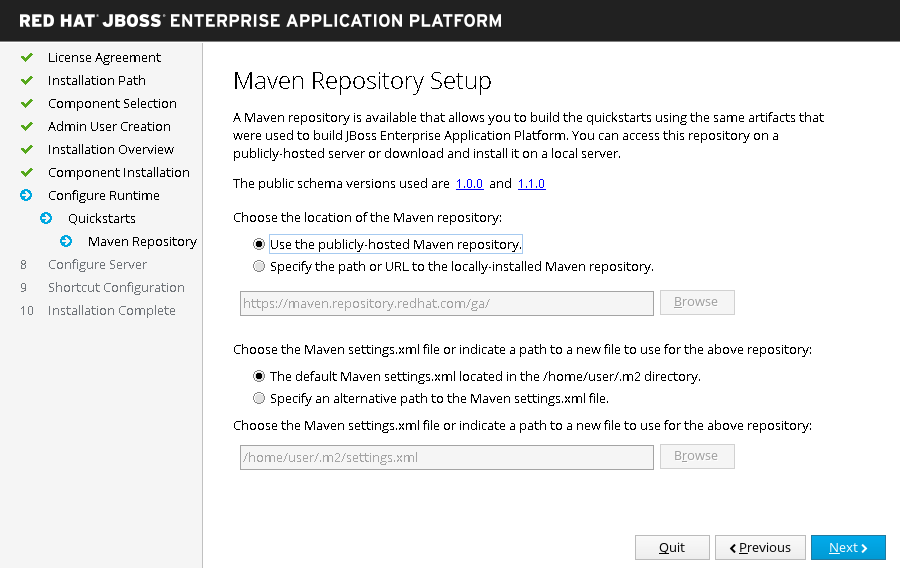
Socket bindings
Choose one of the following options to configure your socket bindings:
- Configure server port bindings in the advanced configuration settings of the runtime environment by configuring port offsets for all default bindings, or configuring custom port bindings. You might need to determine whether the installation uses the default port bindings.
- Configure port offsets by choosing the offset type.
- Configure custom bindings by selecting whether to configure the ports for standalone mode, domain mode, or both.
- If the host is configured for IPv6 only, select the Enable pure IPv6 configuration check box and the installer makes the required configuration changes.
When you have configured your socket binding, click Next.
Figure 3.9. JBoss EAP Installer - Socket bindings screen

Custom socket bindings for Standalone configurations
-
Configure custom port bindings for standalone mode by setting the ports and system properties for each of the standalone configurations (
standalone,standalone ha,standalone full,standalone full-ha), and then click Next.
Figure 3.10. JBoss EAP installer - Custom socket bindings for standalone configurations screen

Custom socket bindings for domain configurations
-
Configure custom port bindings for domain mode by setting the ports and system properties for the host configuration (
domain host) and each of the domain profiles (domain default,domain ha,domain full,domain full-ha), and then click Next.
Figure 3.11. JBoss EAP installer - Custom socket bindings for domain configurations screen

Logging options
You can configure logging levels in the advanced configuration settings of the runtime environment as follows:
a. Select the desired logging levels for the root logger and the console logger.
b. Click Next.
Jakarta server faces setup
You can install a Jakarta Server Faces implementation in the advanced configuration settings of the runtime environment, as follows:
a. Configure the Jakarta Server Faces options and paths to your Jakarta Server Faces JARs.
b. Click Next.
For more information, see Installing a Jakarta Server Faces Implementation in the Configuration Guide.
Figure 3.12. JBoss EAPinstaller - Jakarta server faces setup screen

JDBC driver setup
You can install a JDBC driver in the advanced configuration settings of the runtime environment by installing and setting up a JDBC driver.
a. Choose the appropriate driver vendor from the drop-down list.
b. Specify the driver’s JAR location(s).
c. Click Next.
For more information, see the datasource JDBC driver section in the Configuration Guide.
Figure 3.13. JBoss EAP installer - JDBC driver setup screen

Datasource setup
You can install a JDBC driver and install a datasource in the advanced configuration settings of the runtime environment by configuring a datasource.
a. Provide a datasource name and configure the other options.
b. Click Next.
For more information, see the details of datasource management in the Configuration Guide.
Figure 3.14. JBoss EAP installer - Datasource setup screen
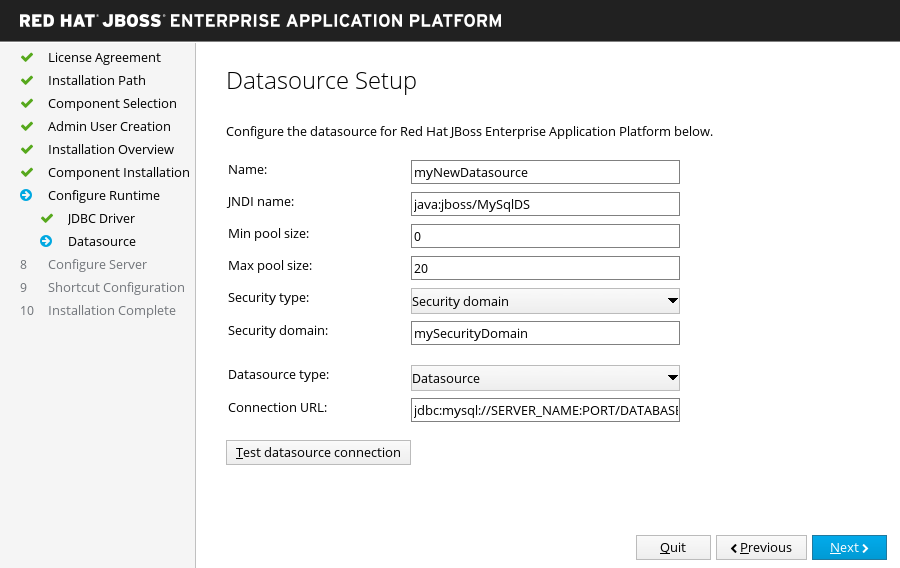
- When the configuration progress completes, click Next.
Select the Create shortcuts in the Start-Menu check box to create shortcuts, and then click Next.
NoteOnly alphanumeric characters, dash (-), and underscore (_) characters are allowed. On Microsoft Windows, the slash (/) and backslash (\) characters are also allowed.
- Click Generate installation script and properties file if you want to capture the selected installation options for a future automated installer installation, and then click Done.
Installation is now complete. The directory created by the installer is the top-level directory for the server. This is referred to as EAP_HOME.
3.3. Running the JBoss EAP text-based installer
You can use the text-based installer to install, configure, and uninstall a JBoss EAP instance. This installer method offers an uncluttered and straightforward experience.
Prerequisites
- Set up an account on the Red Hat Customer Portal.
- Review the JBoss EAP 7 supported configurations and ensure that your system is supported.
- Install a supported Java Development Kit (JDK).
- Download the text-based installer.
- If you are using Windows, set the JAVA_HOME and PATH environment variables. If you do not have this set up, shortcuts do not work.
Procedure
- Open a terminal and navigate to the directory containing the downloaded JBoss EAP installer.
Run the text-based installer using the following command:
$ java -jar jboss-eap-7.4.0-installer.jar -console
-
Follow the prompts to install JBoss EAP. The directory created by the installer is the top-level directory for the server. This is referred to as
EAP_HOME.
Additional resources
-
See Setting up the
EAP_HOMEvariable, in the JBoss EAP Installation Guide.
3.4. Configuring JBoss EAP installer installation as a service on RHEL
You can configure the installer installation to run as a service in Red Hat Enterprise Linux (RHEL).
Prerequisites
- Install the installer.
- Ensure that you have administrator privileges on the server.
Procedure
-
Configure the start-up options in the
jboss-eap.conffile by opening thejboss-eap.confin a text editor and set the options for your JBoss EAP installation. Copy the service initialization and configuration files into the system directories:
Copy the modified service configuration file to the
/etc/defaultdirectory.$ sudo cp EAP_HOME/bin/init.d/jboss-eap.conf /etc/defaultCopy the service startup script to the
/etc/init.ddirectory and give it execute permissions:$ sudo cp EAP_HOME/bin/init.d/jboss-eap-rhel.sh /etc/init.d $ sudo chmod +x /etc/init.d/jboss-eap-rhel.sh
Add the new
jboss-eap-rhel.shservice to the list of automatically started services using thechkconfigservice management command:$ sudo chkconfig --add jboss-eap-rhel.sh
Verify that the service has been installed correctly by using one of the following commands.
For Red Hat Enterprise Linux 6:
$ sudo service jboss-eap-rhel.sh start
For Red Hat Enterprise Linux 7 and later:
$ sudo service jboss-eap-rhel start
The service starts. If the service does not start and you get an error message, check the error logs and make sure that the options in the configuration file are set correctly.
Optional: To make the service start automatically when the Red Hat Enterprise Linux server starts, run the following command:
$ sudo chkconfig jboss-eap-rhel.sh on
Verification
-
To check the permissions of a file, enter the
ls -lcommand in the directory containing the file. To check that the automatic service start is enabled, enter the following command:
$ sudo chkconfig --list jboss-eap-rhel.sh
- For more information about controlling the state of services, see Management system services in the JBoss EAP Configuring basic system settings guide.
- For more information about viewing error logs, see Bootup logging in the JBoss EAP Configuration Guide.
-
To check the permissions of a file, enter the
3.5. Configuring JBoss EAP installer installation as a service on Microsoft Windows Server
You can install JBoss EAP on Microsoft Windows Server using the installer installation method. This method provides a basic default installation of a server, with configuration files and libraries placed in standard folders. The default installation of the server contains a service.bat script that you can use with Jsvc to stop and start JBoss EAP.
If you use the set command to set system environment variables in a Windows Server command prompt it does not permanently set the environment variables. You must use either the setx command, or the System interface in the Control Panel.
Prerequisites
- Install the JBoss EAP installer.
- Ensure that you administrator privileges on the server.
- Set the JAVA_HOME system environment variable.
- Ensure that you have an instance of the JBoss EAP server that is not running.
Procedure
The procedure for configuring JBoss EAP installer installation as a service in Microsoft Windows Server is similar to that of the archive installation method. See Configuring JBoss EAP archive installation as a service on Microsoft Windows Server.
3.6. Installing and running the JBoss EAP installer installation by using Jsvc
You can use the Apache Java Service (Jsvc) component of the JBoss Core Services Apache HTTP Server Installation Guide collection to run JBoss EAP as a detached service, a daemon, on Red Hat Enterprise Linux (RHEL).
Although Jsvc works on RHEL, we strongly recommend that you use the native methods for running JBoss EAP as a service on RHEL.
Jsvc is a set of libraries and applications that provide Java applications the ability to run as a background service. Applications run using Jsvc can perform operations as a privileged user, then switch identity to a non-privileged user.
Prerequisites
- Install the JBoss EAP installer.
- Ensure that you administrator privileges on the server.
- Set the JAVA_HOME system environment variable.
- Ensure that you have an instance of the JBoss EAP server that is not running.
Procedure
The procedure for configuring the JBoss EAP installer installation by using Jsvc is similar to that of the archive installation method. For more information refer to the following sections in the JBoss EAP Installation Guide:
- Installing and starting JBoss EAP installer installation by using Jsvc
- Jsvc commands to start or stop JBoss EAP as a standalone server
- Jsvc commands to start or stop JBoss EAP on a managed domain
- Optional: Configuring JBoss EAP installer installation as a service on Microsoft Windows Server
Additional resources
- For information about controlling JBoss Core Services, see Configuring the Apache HTTP Server Installation in the Apache HTTP Server Installation Guide.
- For information about configuring a JBoss EAP archive installation as a service using Jsvc, see Archive installation of JBoss EAP.
- For information about configuring a JBoss EAP installer installation on a Microsoft Windows server, see Configuring JBoss EAP installer installation as a service on Microsoft Windows Server.
3.7. Using the automated installer installation
If you used the installer installation to install JBoss EAP, you can use an installation script generated from a previous install to automate future installations with the same configuration.
The automated installer is not backward compatible. You cannot use an installation script generated from a previous version of JBoss EAP with the automated installer. Only use installation scripts generated by the same minor version of JBoss EAP. For example JBoss EAP 7.4.
Prerequisites
Use the installer installation to generate an automatic installation script.
- The automatic installation script is an XML file.
Procedure
- Open a terminal and navigate to the directory containing the downloaded JBoss EAP installer file.
Run the following command to install JBoss EAP using the automatic installation script XML file:
$ java -jar jboss-eap-7.4.0-installer.jar auto.xmlBy default, the installer prompts you to enter any passwords required for the JBoss EAP configuration. You can do an unattended install by pre-setting the passwords for the installation.
NoteYou can store the automatic installation script XML file on a network host, and use HTTP or FTP to point the installer to use it for an installation. For example:
$ java -jar jboss-eap-7.4.0-installer.jar http://network-host.local/auto.xml$ java -jar jboss-eap-7.4.0-installer.jar ftp://network-host.local/auto.xml
Additional resources
- See Unattended automated installer installation in the JBoss EAP Installation Guide.
3.8. Unattended automated installer installation
To do an unattended automated installer installation, you must preset the passwords required for the JBoss EAP installation.
When the installation script XML file is generated from a previous installer installation, an incomplete installation script variables file is also generated. It has the same file name as the installation script file, but with a .variables suffix.
The variables file contains a list of key and password parameters needed for an unattended automated installation.
You can provide the required passwords as a completed variables file, or as an argument when running the installer command.
3.9. Providing the password as an argument in the installer command
You can edit the .variables file in a text editor and provide a password value for each key. You can then run the installer by using the automatic installation script. The installer detects the variables file automatically if the completed variables file is in the same directory as the installation script XML file. Additionally, you must not have modified variables file name.
Prerequisites
Use the JBoss EAP installer to generate an automatic installation script.
- The automatic installation script is an XML file.
Procedure
Open the
.variablesfile in a text editor and provide a password value for each key. The following example demonstrates setting a password value for a key:adminPassword = password#2 vault.keystorepwd = vaultkeystorepw ssl.password = user12345
Run the installer using the automatic installation script XML file:
$ java -jar jboss-eap-7.4.0-installer.jar auto.xml Checking for corresponding
.variablesfile Variables file detected: auto.xml.variables [ Starting automated installation ] ...
3.10. Providing the password as a completed variables file
You can use the -variablefile option in the management CLI to specify a path to the variables file. You can then run the installer using the automatic installation script to specify passwords as key or value pairs using the -variables argument.
Prerequisites
Use the JBoss EAP installer to generate an automatic installation script.
- The automatic installation script is an XML file.
Procedure
Specify the path to the variables file using
-variablefile:$ java -jar jboss-eap-7.4.0-installer.jar auto.xml -variablefile auto.xml.variables
Run the installer using the automatic installation script XML file and specify the required passwords as key/value pairs using the
-variablesargument, as demonstrated in the following example:$ java -jar jboss-eap-7.4.0-installer.jar auto.xml -variables adminPassword=password#2,vault.keystorepwd=vaultkeystorepw,ssl.password=user12345
NoteCheck that you have not entered any spaces when specifying the
-variableskey or value pairs.
3.11. Uninstalling a JBoss EAP installer with the graphical uninstaller
If you installed JBoss EAP using the installer, you can uninstall JBoss EAP using the graphical uninstaller. The graphical uninstaller offers a convenient way to uninstall the JBoss EAP installer in a few simple steps.
Prerequisites
- Install the JBoss EAP installer.
- Ensure that you administrator privileges on the server.
- Set the JAVA_HOME system environment variable.
- Ensure that you have an instance of the JBoss EAP server that is not running.
Procedure
-
Open a terminal and navigate to
EAP_HOME/Uninstaller. Run the graphical uninstaller using the following command:
$ java -jar uninstaller.jar
The graphical uninstaller is similar to the following figure. Select the check box if you want to delete the JBoss EAP installation directory.
Figure 3.15. JBoss EAP graphical uninstaller

- Click Uninstall to start the uninstall process.
- When the uninstall process is finished, click Quit to exit the uninstaller.
3.12. Uninstalling JBoss EAP installer installation with the text uninstaller
If you installed JBoss EAP using the installer, you can uninstall JBoss EAP using the text uninstaller. The text uninstaller offers a simpler way to manually uninstall the JBoss EAP installer.
Prerequisites
- Install the JBoss EAP installer.
- Ensure that you have administrator privileges on the server.
- Set the JAVA_HOME system environment variable.
- Ensure that you have an instance of the JBoss EAP server that is not running.
Procedure
-
Open a terminal and navigate to
EAP_HOME/Uninstaller. Run the text-based uninstaller using the following command:
$ java -jar uninstaller.jar -console
- Follow the prompts to uninstall JBoss EAP.

